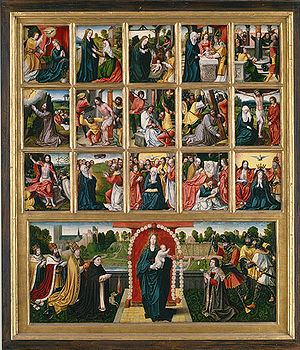Seven Joys of the Virgin

The Seven Joys of the Virgin (or of
The Seven Joys were frequently depicted in medieval devotional literature and art. The seven joys are usually listed as:
- The Annunciation
- The Nativity of Jesus
- The Adoration of the Magi
- The Resurrection of Christ
- The Ascension of Christ to Heaven
- The Pentecost or Descent of the Holy Spirit upon the Apostles and Mary
- The Coronation of the Virgin in Heaven [1][2]
Alternative choices were made and might include the
| Part of a series on the |
| Mariology of the Catholic Church |
|---|
 |
|
Catholicism portal |
Originally, there were five joys of the Virgin.
The Seven Joys of Our Blessed Lady in Heaven
According to Pelbartus Ladislaus of Temesvár, St. Thomas, while he was reciting his daily 'Hail Mary's in memory of the principal joys of Mary, was "favored with an apparition of the Queen of Heaven." She encouraged him to add seven more 'Hail Mary's in honor of "the seven signal joys she possesses in heaven, and to instill the same devotion into the minds of others."[5]
This devotion of the Seven Joys of Our Blessed Lady in Heaven recounts the glories Mary was honored with in heaven after her dormition.
See also
- Franciscan Crown - rosary commemorating the seven joys of Mary
- Life of Jesus in the New Testament
- The Seven Joys of Mary (carol) - traditional carol
- Seven Sorrows of Mary
References
- ^ ISBN 0-87973-910-X.
- ISBN 0-85331-270-2
- ^ George Coffin Taylor, "Relations of Lyric and Drama in Mediaeval England," Modern -Philology, January 1907, p. 6
- ISBN 0-7100-8695-4
- ^ Daughters of Charity of St. Vincent de Paul. (1856). . St. Vincent's Manual. John Murphy & Co.

